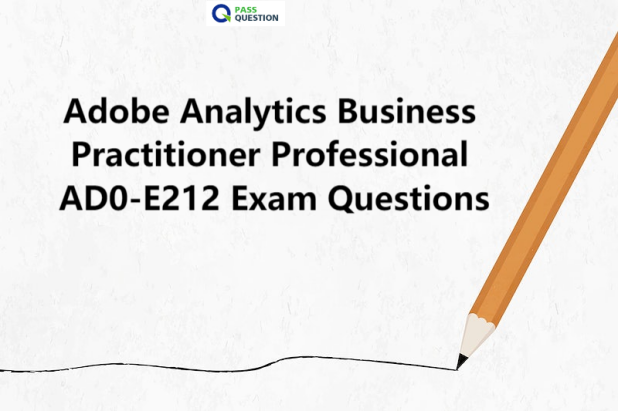
Exam Details
Are you preparing to take the AD0-E212 Adobe Analytics Business Practitioner Professional exam? PassQuestion offers a comprehensive collection of the most up-to-date Adobe Analytics Business Practitioner Professional AD0-E212 Exam Questions, meticulously designed to cover all exam objectives. Our expertly crafted AD0-E212 Exam Questions are tailored to enhance your understanding of key concepts and boost your confidence, ultimately increasing your chances of passing the exam with flying colors. Don't leave your success to chance – trust PassQuestion Adobe Analytics Business Practitioner Professional AD0-E212 Exam Questions to guide you towards easily achieving your Adobe Analytics certification goals.

Level: Professional (0-12 months' experience)
Passing Score: 31/50
Time: 100 mins
Delivery: Online proctored
Available languages: English
Cost: $125 (global) / $95 (India)
Exam ID: AD0-E212
Minimum experience
- You should have a minimum of 3 months of experience in Adobe Analytics and the following experience:
- A marketing background or come from a marketing role but can come from a variety of job roles.
- A basic familiarity with digital analytics metrics and dimensions.
- The ability to use Analytics to build reports and answer business questions, and communicate the results.
- An understanding of basic digital analytics concepts like segmentation, report building, standard metric definitions.
Exam Objectives and Scope
This section provides information on the exam content.
Section 1: Business analysis (34%)
- Given a business need/question, identify an appropriate reporting strategy to perform an analysis
- Analyze data to answer business questions
- Identify conversion funnels (as a concept to understand business analysis)
- Consult the Solution Design Reference (SDR) to determine what data is available in reports
- Analyze report data to summarize and draw conclusions
- Recognize outliers and anomalies in reports
Section 2: Reporting and dashboarding for projects (38%)
- Consider the advantages of using specific visualizations based on a given scenario
- Compare fallout and flow visualization
- Apply the process to schedule and share Projects for different users and/or groups
- Apply the process to look up and combine dimensions, metrics, date ranges, and segments
- Apply the process to create a visualization
- Given a scenario, determine the appropriate item to use
- Report on marketing campaign performance
Section 3: Segmentation and calculated metrics (19%)
- Determine how to develop and configure basic segments using best practices
- Apply the process to share segments with others in the organization
- Apply segments to Projects and Components
- Apply the process to generate basic calculated and/or segmented metrics
Section 4: General tool knowledge and troubleshooting (9%)
- Understand different types of dimensions and parameters existing in Adobe Analytics (evars, props, and events)
- Determine how to export data from Adobe Analytics
View Online Adobe Analytics Business Practitioner Professional AD0-E212 Free Questions
1. In a given scenario where you need to display monthly sales, customer growth, and product popularity, which visualizations would be most appropriate? (Choose Three)
A. Bar chart for monthly sales
B. Line graph for customer growth
C. Pie chart for product popularity
D. Table for displaying detailed data
E. Map for geographic data distribution
Answer: A, B, C
2. Basic segments should be configured to reflect _______.
A. complex mathematical models
B. specific user behaviors
C. general trends only
D. data from external sources
Answer: B
3. Which of the following methods are effective in analyzing report data to summarize and draw conclusions? (Choose Two)
A. Trend analysis
B. Cluster analysis
C. Random sampling
D. Benchmarking
Answer: A, D
4. Given a business need to optimize operational efficiency, which reporting strategy should be prioritized?
A. Financial reporting
B. Customer satisfaction analysis
C. Process analytics
D. Competitor analysis
Answer: C
5. What are key benefits of using specific visualizations in reports? (Choose Two)
A. Enhancing data comprehension
B. Reducing the need for textual explanation
C. Increasing the data processing time
D. Improving aesthetic appeal of reports
Answer: A, B
6. How does applying the process to create a visualization benefit the end-user in terms of data analysis?
A. Allows for manual data entry
B. Simplifies complex data sets into understandable formats
C. Reduces the amount of data storage required
D. Eliminates the need for data security
Answer: B
7. When applying the process to look up and combine dimensions, metrics, date ranges, and segments, which steps are crucial? (Choose Three)
A. Selecting the relevant data sources
B. Choosing an aesthetically pleasing color scheme
C. Defining the data extraction logic
D. Configuring the data blending options
E. Setting appropriate privacy controls
Answer: A, C, D
8. To ensure accurate data collection, what should be verified in the tracking code implementation?
A. The presence of eVars and props
B. The frequency of data exports
C. The configuration of dashboard widgets
D. The synchronization with external data sources
Answer: A
9. Which of the following would be most important when identifying an appropriate reporting strategy to perform an analysis for a new market entry? (Choose Two)
A. Current market size
B. Past financial reports
C. Competitor analysis
D. Regulatory considerations
Answer: A, C
10. When reporting on marketing campaign performance, which metric is not typically analyzed?
A. Click-through rate
B. Bounce rate
C. Cost per acquisition
D. Employee satisfaction
Answer: D
Related Courses and Certification
Also Online IT Certification Courses & Online Technical Certificate Programs

